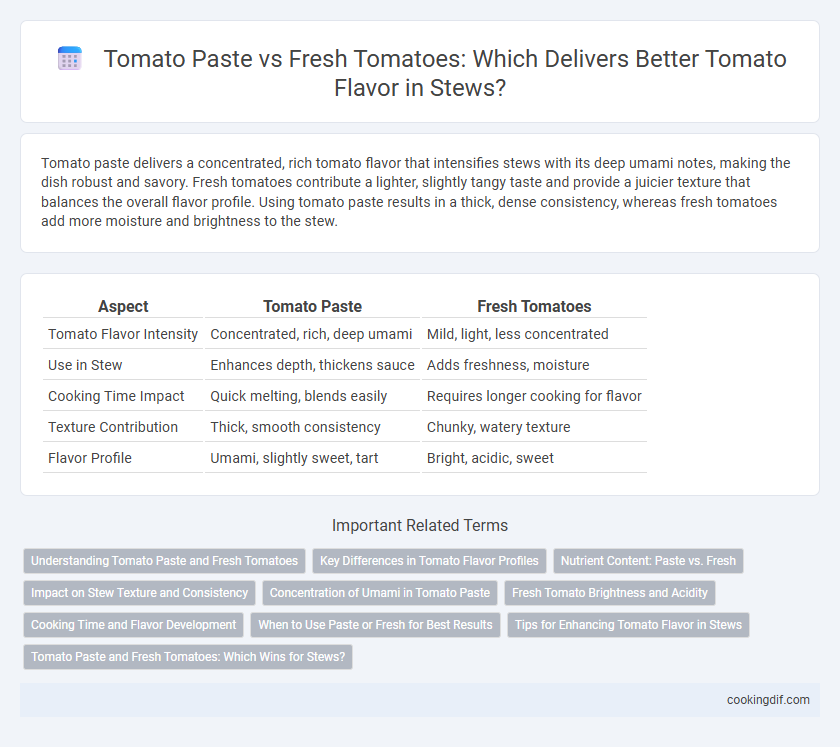Tomato paste delivers a concentrated, rich tomato flavor that intensifies stews with its deep umami notes, making the dish robust and savory. Fresh tomatoes contribute a lighter, slightly tangy taste and provide a juicier texture that balances the overall flavor profile. Using tomato paste results in a thick, dense consistency, whereas fresh tomatoes add more moisture and brightness to the stew.
Table of Comparison
| Aspect | Tomato Paste | Fresh Tomatoes |
|---|---|---|
| Tomato Flavor Intensity | Concentrated, rich, deep umami | Mild, light, less concentrated |
| Use in Stew | Enhances depth, thickens sauce | Adds freshness, moisture |
| Cooking Time Impact | Quick melting, blends easily | Requires longer cooking for flavor |
| Texture Contribution | Thick, smooth consistency | Chunky, watery texture |
| Flavor Profile | Umami, slightly sweet, tart | Bright, acidic, sweet |
Understanding Tomato Paste and Fresh Tomatoes
Tomato paste contains concentrated tomato flavor with a rich, umami taste, delivering a deep, intense tomato essence in stews. Fresh tomatoes provide a brighter, lighter, and slightly acidic flavor, contributing natural sweetness and juiciness that balances heavier ingredients. Choosing between tomato paste and fresh tomatoes affects the stew's texture and taste, as paste thickens the dish while fresh tomatoes add moisture and subtle complexity.
Key Differences in Tomato Flavor Profiles
Tomato paste offers a concentrated, rich, and slightly sweet tomato flavor due to its reduction process, making it ideal for stews that require a deep, robust taste. Fresh tomatoes provide a brighter, more acidic, and lighter tomato profile, contributing freshness and a slightly tangy note to the dish. The choice between tomato paste and fresh tomatoes in stew hinges on balancing intensity and brightness to achieve the desired tomato flavor depth.
Nutrient Content: Paste vs. Fresh
Tomato paste contains a concentrated amount of nutrients like lycopene, vitamin C, and potassium compared to fresh tomatoes, providing a richer tomato flavor in stew. The cooking process involved in making tomato paste enhances lycopene bioavailability, which acts as a powerful antioxidant. Fresh tomatoes offer higher water content and a subtle balance of vitamins and minerals, but their nutrient density is lower than the concentrated paste.
Impact on Stew Texture and Consistency
Tomato paste intensifies stew texture by adding a thick, concentrated base that enhances body and richness, creating a velvety consistency. Fresh tomatoes contribute a lighter, more watery texture with subtle acidity, often leading to a thinner stew that retains some chunkiness. Combining both ingredients allows a balance of deep flavor and desirable stew viscosity, optimizing mouthfeel and depth.
Concentration of Umami in Tomato Paste
Tomato paste contains a significantly higher concentration of umami compounds like glutamates compared to fresh tomatoes, intensifying the savory depth of stews. The slow cooking process used to make tomato paste reduces water content and concentrates natural sugars and amino acids, enhancing rich, robust flavors. Using tomato paste instead of fresh tomatoes results in a more pronounced and lasting umami taste, elevating the overall complexity of the dish.
Fresh Tomato Brightness and Acidity
Fresh tomatoes provide a vibrant brightness and natural acidity that enhances the complexity and freshness of a stew's tomato flavor. The bright, tangy notes in fresh tomatoes balance richness and add a lively sharpness, which tomato paste often lacks due to its concentrated and cooked-down profile. Incorporating fresh tomatoes yields a more nuanced and refreshing taste, elevating the stew's overall flavor dimension.
Cooking Time and Flavor Development
Tomato paste delivers a concentrated tomato flavor that intensifies with longer cooking times, enhancing the stew's richness and depth. Fresh tomatoes offer a brighter, more delicate taste but require extended cooking to break down and meld into the stew's base. Using tomato paste shortens the cooking time needed for robust flavor development compared to fresh tomatoes, which slowly release sugars and acids as they cook.
When to Use Paste or Fresh for Best Results
Tomato paste delivers a concentrated, rich tomato flavor ideal for long-simmered stews, enhancing depth and umami without adding extra liquid. Fresh tomatoes bring a bright, slightly acidic taste best suited for recipes requiring a lighter, fresher tomato profile or shorter cooking times. For the most balanced stew, use tomato paste to build a robust base and fresh tomatoes to add freshness and texture.
Tips for Enhancing Tomato Flavor in Stews
Using tomato paste in stews intensifies the tomato flavor due to its concentrated nature and caramelized notes from cooking, making it ideal for deep, rich stews. Fresh tomatoes contribute a brighter, fresher taste with a slight acidity that balances heavier ingredients and adds complexity. For optimal tomato flavor, combine a small amount of tomato paste early in the cooking process with fresh tomatoes added later to preserve their brightness and layered taste.
Tomato Paste and Fresh Tomatoes: Which Wins for Stews?
Tomato paste delivers a concentrated, rich umami depth that intensifies stew flavors without adding extra liquid, making it ideal for thick, hearty dishes. Fresh tomatoes offer a lighter, more acidic, and slightly sweet profile that brightens the stew but can dilute the consistency. For stews requiring robust, savory complexity, tomato paste generally outperforms fresh tomatoes in flavor impact and texture control.
Tomato paste vs fresh tomatoes for tomato flavor Infographic

 cookingdif.com
cookingdif.com